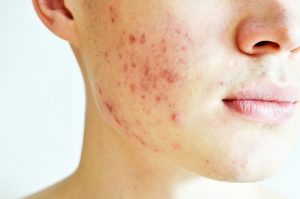Chocolate is one of the indulgences people enjoy, but does chocolate cause acne? Several studies about the effects of chocolate on the skin have been discussed in a recent CNN article.
The results are complicated. There is milk chocolate that has higher sugar content and sugar is one of the food components known to cause acne breakouts. Then there is dark chocolate with a chocolate content of 85% to 99%. As we will see some people prone to acne can still break out with pimples even with 99% dark chocolate. The problem is that dark chocolate still contains cocoa butter, which consists of oleic acid and stearic acid. Oleic acid has also an association with acne.
Clinical trials to solve the question: does chocolate cause acne?
Sebaceous glands secrete an oily substance, called sebum. Sebum is supposed to moisturize the skin. But acne-prone individuals will overproduce sebum and this combines with dead skin cells. Skin pores can trap the sebum and the dead skin cells and form blackheads, whiteheads and pimples. Blood sugar spikes from eating too much refined sugar causes insulin spikes. And the fact is that insulin spikes cause acne.
Does Chocolate Cause Acne? Chocolate bars versus jellybeans
In one experiment participants were eating either one chocolate bar every day or 5 jellybeans daily, after which there was a count of the acne lesions. Both had the same additional glycemic load, which made sure that their insulin response was the same. Interestingly, the jellybeans did not change the acne. But the chocolate bar consumers had 5 additional pimples every day. This indicates that it is not only sugar that causes acne. It is the combination of sugar and something in the chocolate. Could it be oleic acid?
Does Chocolate Cause Acne? Milk and sugar are also culprits for acne
According to Dr. Gregory R. Delost of the Department of Dermatology at University Hospitals, Cleveland Medical Center there are a number of research papers about milk and sugar. Both in combination have been shown to cause acne in sensitive individuals who are prone to develop acne.
Does 99% chocolate cause acne?
The next experiment was to feed a group of acne-prone males 25 grams of 99% chocolate for 4 weeks. A count of blackheads and whiteheads was the next step. There was a significant increase in the group that ate the 99% chocolate in comparison to a control group who did not eat this. The conclusion was that pure 99% chocolate could indeed cause acne.
Dr. Brian Berman, emeritus professor of dermatology and cutaneous surgery at the University of Miami, had done a double-blind and placebo-controlled study with 100% chocolate. He found that the subjects who consumed 100% chocolate had significantly more acne lesions than controls.
With these two studies it is clear that 99% or 100% chocolate without milk or sugar still has acne-promoting qualities. According to Dr. Berman this is due to the fat from the cocoa butter. The most likely cause is the oleic acid component, not the stearic acid.
Conclusion
The question whether chocolate can cause acne is not easy to answer. It is more complicated than a simple “yes” or “no”. One thing is sure, that cheap chocolate with only 40 to 60% of cacao will cause acne in acne-prone teenagers. The reason is the combination of milk and sugar in milk chocolate. But experiments with pure chocolate where only cacao is mixed with cacao butter showed that it could indeed cause acne in acne-prone teenagers. Other research has shown that the oleic acid in cacao butter likely is responsible for it. Stearic acid, the other component of cacao, butter is neutral. It may be sad news for chocolate lovers, but if you are acne-prone, and 99% or 100% chocolate causes you to get pimples, it means that you should refrain from chocolate.
Good news, if you pass the challenge test
If you don’t get pimples from this challenge test, you can indulge in dark chocolates without counting any more blackheads or pimples. It is still a good idea to enjoy it with moderation: two ounces per day should be enough!







